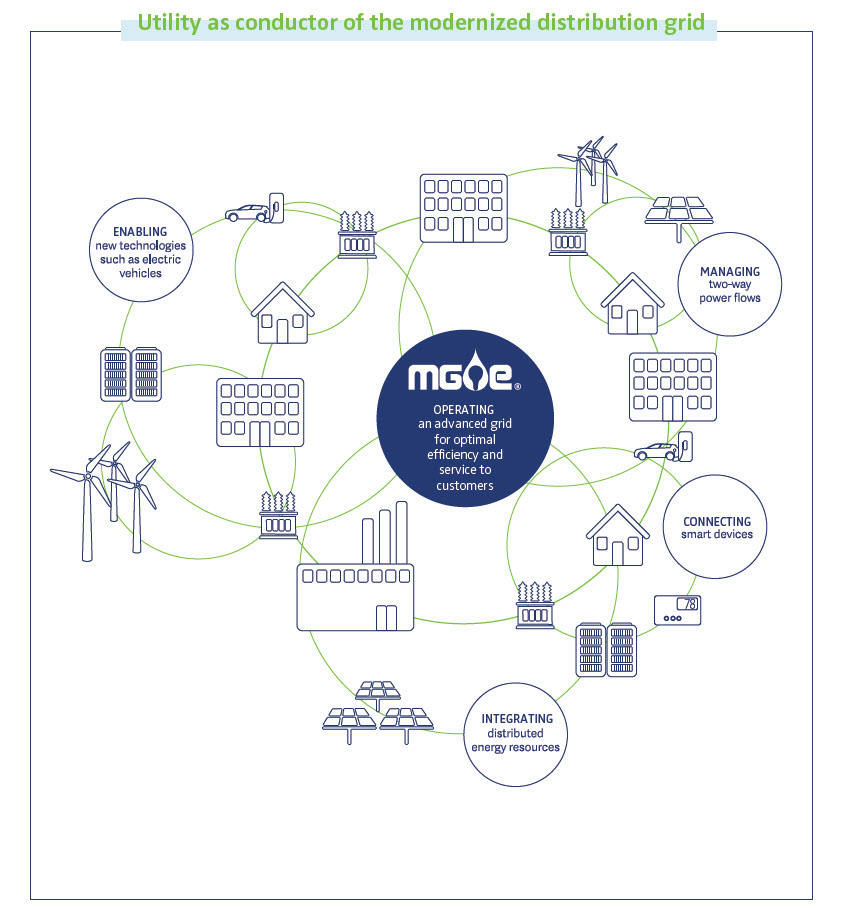Strategy and Climate
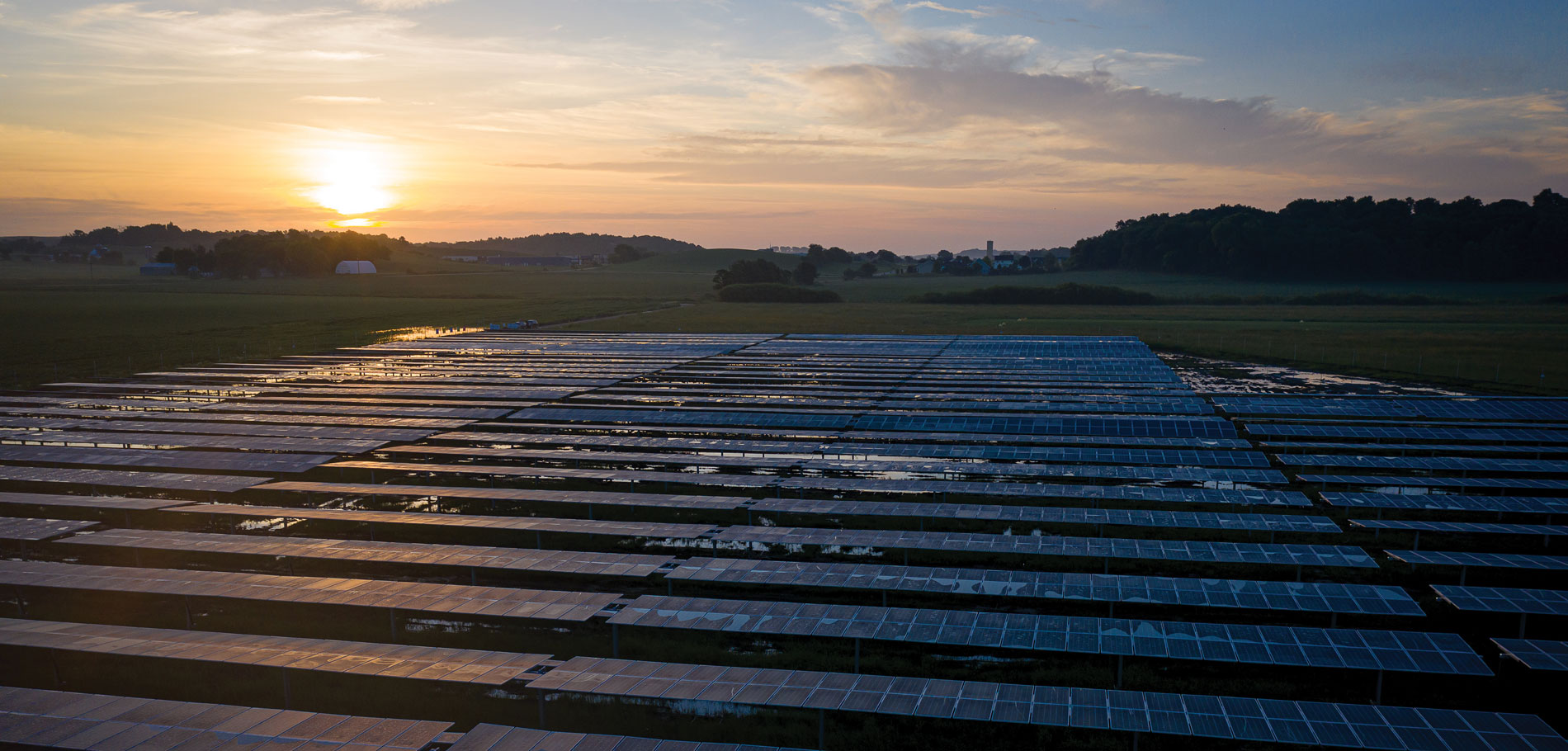
Highlights
- MGE is working together with our customers toward net-zero carbon electricity by 2050. We expect to achieve carbon reductions of at least 65% by 2030. MGE already has reduced carbon emissions 30% from 2005 levels.
- MGE is decarbonizing its electricity generation, projecting an estimated total of $565 million in nearly 400 megawatts (MW) of wind, solar and battery storage between 2015 and 2024.
- As a minority owner, MGE is working with the co-owners of the Columbia Energy Center to retire the coal-fired plant by the end of 2024. By 2030, MGE’s remaining use of coal is expected to be reduced substantially. We expect to eliminate coal as an energy source by 2035 when the jointly owned Elm Road Generating Station stops using coal.
- Our partnership with the University of Wisconsin-Madison is helping to ensure our carbon reduction goals and decarbonization strategies are consistent with climate science.
- With energy efficiency a key decarbonization strategy, MGE is engaging with customers and offering innovative programs, products and services to help manage our collective energy use.
- We are advancing electric transportation with a robust customer education program, a home charging program and a public charging network. MGE also has an electric vehicle (EV) fleet goal of 100% all-electric or plug-in hybrid light-duty vehicles by 2030.
- MGE is working to ensure that all customers benefit from new technologies in our clean energy transition.
MGE is building a utility of the future, advancing clean energy and new technologies for the benefit of all. Through our partnerships with our customers, investors and broader community, we are using the latest climate science to inform our plans for deep decarbonization while fulfilling our mission to provide safe, reliable, affordable and sustainable energy to our communities.
Powering a more sustainable future
In May 2019, we announced a goal of net-zero carbon electricity by the year 2050. MGE was one of the first utilities in the nation to commit to net-zero by mid-century.
This target is based on the latest climate science. It is consistent with the work of the Intergovernmental Panel on Climate Change (IPCC) and its assessment of limiting global temperature increases to 1.5 degrees Celsius.
Our 2050 goal reflects our vision and signals our direction, but it doesn’t determine our pace. Every decision we make is in the context of achieving deep decarbonization as quickly as we can and consistent with the latest climate science while fulfilling our obligation as a provider of safe, reliable, affordable and sustainable energy.
Achieving net-zero by 2050 will require the use of technologies not yet commercially available or cost-effective, but we are well on our way toward realizing our commitment to greater sustainability, to continued industry leadership and to those we serve.
Continuing transition toward cleaner energy sources
MGE, along with its utility partners, announced in early 2021 plans to retire the approximately 1,100-megawatt (MW) coal-fired Columbia Energy Center near Portage, Wis. The plan represents another step in MGE’s ongoing transition toward greater use of cleaner energy sources and deep carbon reductions. MGE announced several years ago it was transitioning away from coal. In 2016, the company reduced its minority ownership in the plant.
Columbia is co-owned by Alliant Energy and Wisconsin Public Service. Alliant Energy operates the plant. MGE, as minority owner, and the co-owners intend to retire Unit 1 by the end of 2023 and Unit 2 by the end of 2024.
In late 2021, MGE announced plans to eliminate coal-fired generation from its portfolio by 2035. MGE is a minority owner of the coal-fired Elm Road Generating Station in Oak Creek, Wis., which is co-owned by WEC Energy Group, whose subsidiary serves as operator, and by WPPI Energy, Inc.
By working with the plant’s co-owners to transition to natural gas as the primary fuel source at Elm Road, MGE expects to substantially reduce the use of coal at Elm Road by 2030 and to have no coal-fired power plants in its portfolio by 2035.
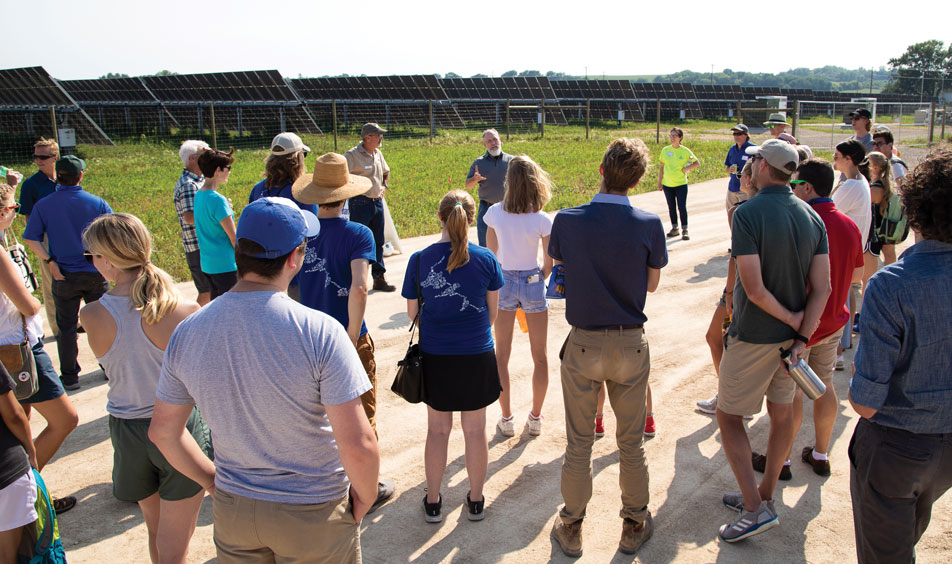 Students from the UW-Madison and others learn about the O’Brien Solar Fields from MGE renewable and distributed energy engineers Dan Clausen and Todd Montevideo.
Students from the UW-Madison and others learn about the O’Brien Solar Fields from MGE renewable and distributed energy engineers Dan Clausen and Todd Montevideo.
Climate science partnership with the University of Wisconsin
To inform our work for achieving deep decarbonization and net-zero carbon by 2050, MGE is working with Dr. Tracey Holloway at the University of Wisconsin-Madison’s Nelson Institute for Environmental Studies and the Department of Atmospheric and Oceanic Sciences. In 2020, Dr. Holloway used climate modeling available through the IPCC for an analysis of MGE operations and our deep decarbonization goal. The models suggested that by 2050, emissions from electricity generation in industrialized countries should be 87% to 99% lower than the 2005 baseline. MGE’s goal is net-zero carbon emissions by 2050, which is a 100% reduction from 2005 levels. The analysis showed MGE’s goal is in line with model benchmarks to limit global warming to 1.5 degrees Celsius.
The UW-Madison report, Interpreting Global Energy Scenarios for Emissions Planning at the Utility Scale, is available at minds.wisconsin.edu and mge.com/netzeroreport.
Progress toward our carbon reduction goals
Since 2015, MGE has announced an estimated $565 million in clean energy projects, which are expected to increase MGE’s owned renewable capacity by more than nine times when completed by 2024.
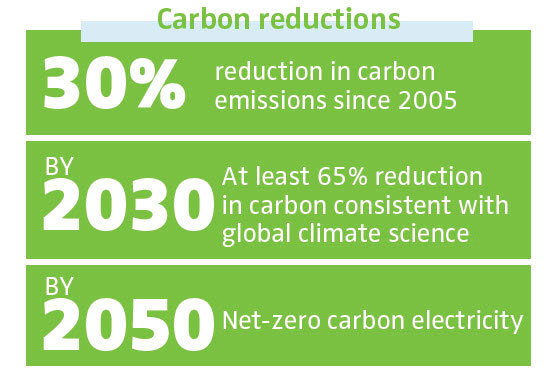
MGE already has reduced carbon emissions 30% since 2005, our baseline. Under our Energy 2030 framework for a more sustainable future, introduced in November 2015, we committed to reducing carbon emissions at least 40% by 2030. Consistent with the science, MGE expects to achieve carbon reductions of at least 65% by 2030.
Energy 2030 also established a goal of 30% renewable energy by 2030 and an interim goal of 25% by 2025, which we expect to exceed by year-end 2022. We have said since establishing our goals that if we can go further faster by working with our customers, we will.
Our strategies for deep decarbonization
The U.S. Mid-Century Strategy (MCS) for Deep Decarbonization is the United States’ strategy for meeting the goals of the Paris Agreement on climate change to limit global warming. Both the MCS and the IPCC rely on decarbonizing electric generation, using energy efficiently and electrifying other energy uses, including transportation. These are the strategies MGE is pursuing and will continue to pursue to achieve deep decarbonization and net-zero carbon electricity. Our aggressive goals and pursuit of rapid and deep decarbonization also are in line with the IPCC Working Group I report, Climate Change 2021: The Physical Science Basis, which notes that immediate, rapid and large-scale reductions in greenhouse gas emissions are needed to limit global warming.
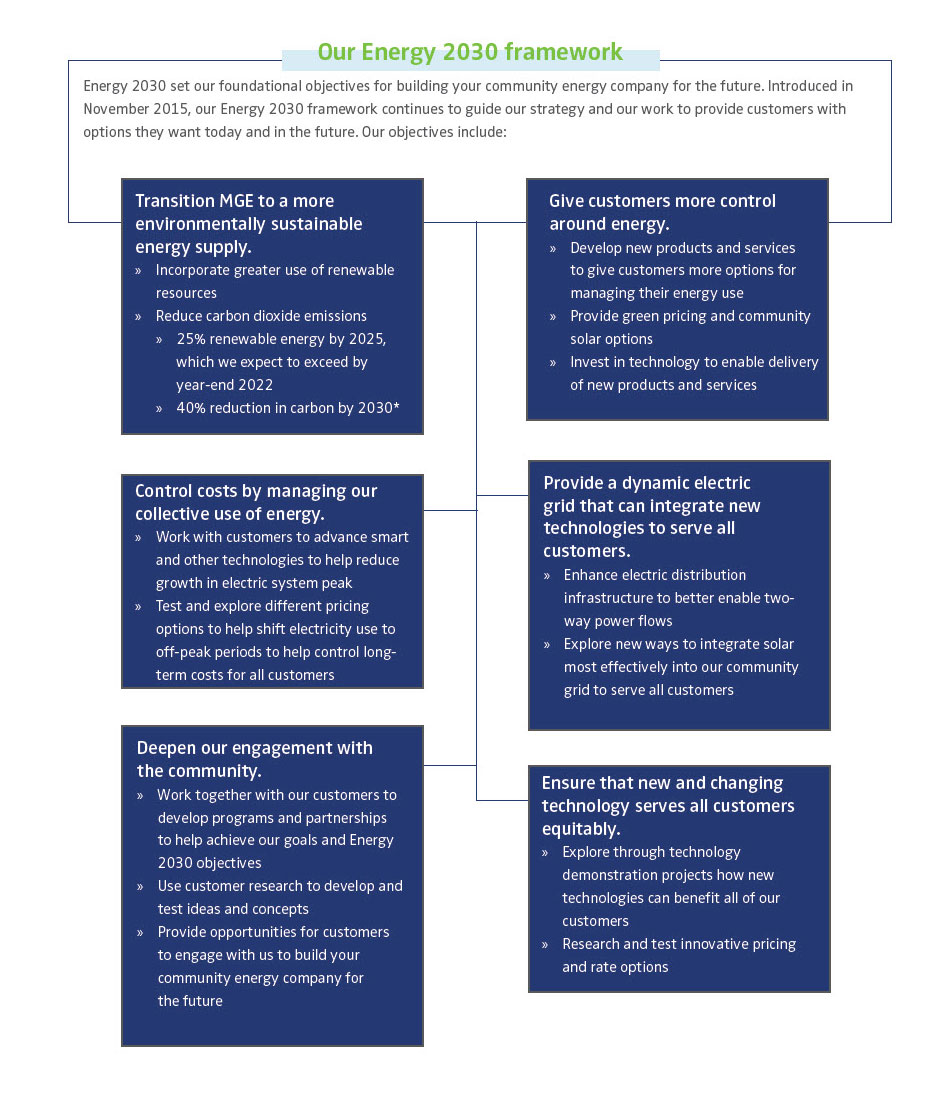
*MGE has since committed to at least 65% reduction in carbon emissions by 2030.
Growing our use of clean energy
Since announcing our Energy 2030 framework in November 2015, we have developed projects that we expect will increase our owned renewable capacity by roughly nine times by the end of 2024. Growing our use of renewable resources is a part of our strategy for achieving net-zero carbon electricity by 2050.
Resource planning and carbon regulation
When making generation decisions, MGE engages in extensive resource planning analysis and modeling, which consider many factors including forecasted energy use projections; long-term impacts on customers, investors and the environment; potential future environmental regulations; assumptions related to the anticipated costs of fuel and many other factors related to energy production. Our economic analysis explicitly includes possible projected carbon emissions limits to help ensure our decisions are financially sound—regardless of whether or how carbon is regulated in the future.
In addition, large new generating facilities are reviewed by the Public Service Commission of Wisconsin to ensure the projects are in the public interest. For larger projects, different generating scenarios are modeled in our regulatory application to demonstrate the need and to justify the cost. All proposals and decisions by the state regulatory body are part of the public record.
Ongoing transition from fossil fuels
MGE has no controlling interest in coal-fired resources and announced several years ago that we would not be investing further in coal-fired plants. In 2011, MGE discontinued the use of coal at the only generating facility in which we have sole ownership, our Blount Generating Station.
Additionally, as part of a rate case settlement agreement in 2018, MGE accelerated the depreciation of certain assets, including our combustion turbines, Blount Generating Station and Columbia Energy Center Unit 1. The accelerated depreciation schedule and retirement of coal-fired generation will help the company move forward with investments in cleaner sources of energy. In 2021, MGE, as a minority owner, and the co-owners of the Columbia Energy Center announced the planned retirement of the plant by 2025.
Generating facilities
- Badger Hollow Solar Farm, Iowa County (Phase II is expected online in 2022)
- Blount Generating Station, Madison
- Columbia Energy Center, Portage (expected retirement of all units by 2025)
- Combustion turbines, Madison and Marinette
- Dane County Airport Solar, Madison
- Elm Road Generating Station, Oak Creek (expected to stop using coal by 2035)
- Forward Energy Center wind farm, Dodge and Fond du Lac counties
- Hermsdorf Solar Fields, Madison (under construction in 2021)
- Morey Field Solar, Middleton
- O’Brien Solar Fields, Fitchburg
- Rosiere Wind Farm, Kewaunee County
- Saratoga Wind Farm, Howard County, Iowa
- Shared Solar, Middleton
- Solar photovoltaic units, Dane County
- Top of Iowa Wind Farm, Worth County, Iowa
- Two Creeks Solar, Manitowoc County
- West Campus Cogeneration Facility, Madison
We also purchase power through contracts and from the Midcontinent Independent System Operator market.
Reducing emissions
We have made strides to reduce emissions by installing emission reduction equipment and improving equipment efficiencies with our current generation fleet. As we work toward our ambitious goal of net-zero carbon electricity by 2050, we continue to make significant investments in local and regional, cost-effective renewable generation. Ensuring that new and changing technology serves all customers equitably is one of our key objectives under our Energy 2030 framework. We are working to build a smarter, cleaner community grid that serves to benefit all customers.
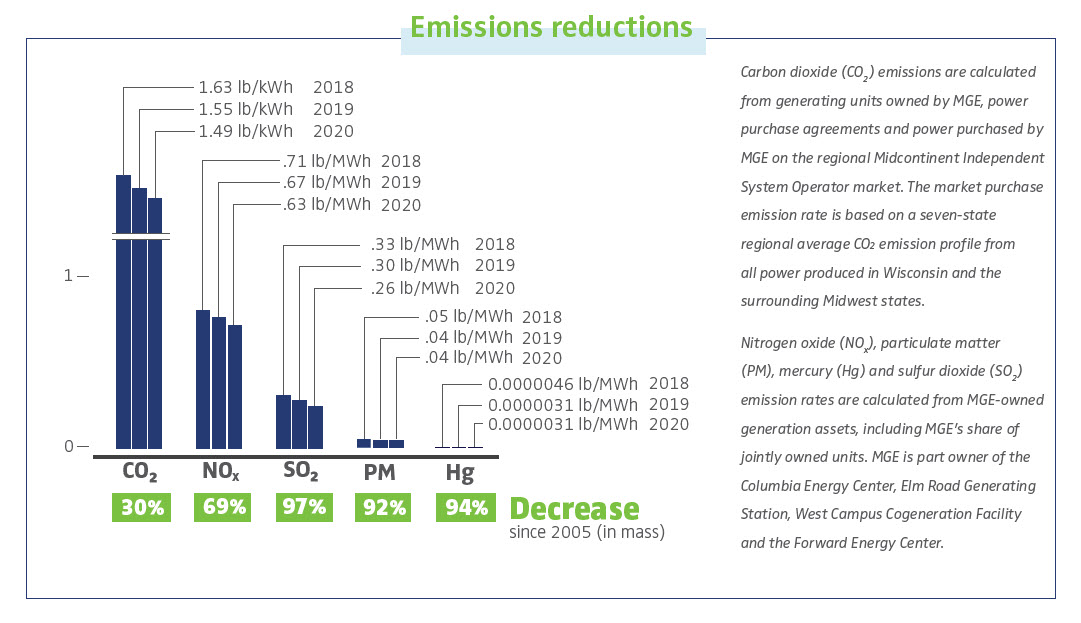
Harnessing renewable natural gas
MGE continues to reduce greenhouse gas (GHG) impacts with an initiative that generates electricity from the combustion of methane, which is produced locally by cow manure. As a GHG, methane is at least 25 times more potent than carbon; however, methane as a fuel burns much cleaner and produces 50% less GHGs than coal.
MGE receives energy from a manure digester. The digester converts cow manure from local farms into electricity. For 2020, the manure digester generated more than 9.3 million kilowatt-hours (kWh) of electricity, which is enough to power more than 1,500 households.
Under an Environmental Protection Agency requirement, MGE monitors, measures and reports several GHG emissions annually. MGE tracking covers power plant emissions, natural gas distribution and smaller combustion sources.
Edison Electric Institute ESG/sustainability reporting templates
To advance further transparency and disclosure in company operations and governance, MGE participates in the Edison Electric Institute’s (EEI) environmental, social and governance (ESG)/sustainability-related reporting templates. The quantitative template includes data related to MGE’s energy portfolio (generation and capacity), emissions, capital expenditures, and human and natural resources. The qualitative template includes information related to our company’s management and oversight of and strategies for transitioning toward deep decarbonization and greater sustainability. These templates are voluntary and industry-specific. Find them at mgeenergy.com/environment.
Our clean energy projects
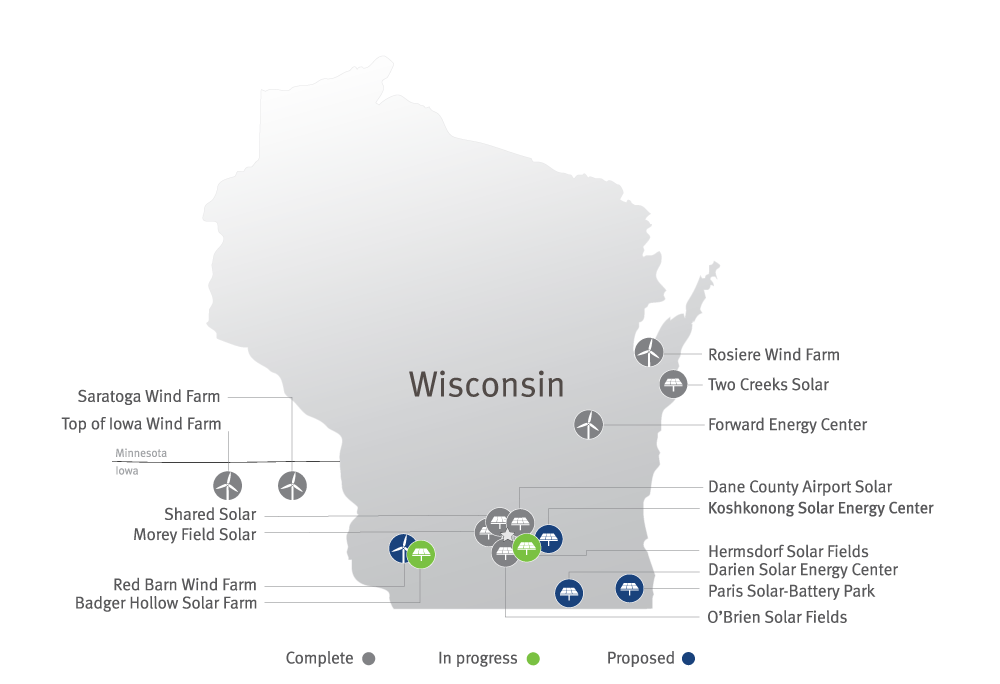
- Purchasing 100 megawatts (MW) of solar capacity from the Badger Hollow Solar Farm in Iowa County, Wis., Badger Hollow Phase I came online in 2021; another 50 MW from Phase II is expected online in 2022.
- Purchasing 50 MW of solar capacity from the Two Creeks Solar project, which came online in 2020.
- Bringing online the 20-MW O’Brien Solar Fields in Fitchburg, Wis. The array serves local companies, the City of Fitchburg, the State of Wisconsin and the University of Wisconsin-Madison through our innovative Renewable Energy Rider (RER) program.
- Partnering with Dane County to build a 9-MW solar installation at the Dane County Regional Airport in Madison, Wis., which came online in 2020 to serve Dane County operations.
- Partnering with the City of Madison and the Madison Metropolitan School District to build the 8-MW Hermsdorf Solar Fields in Madison, which is under construction.
- Expanding our highly successful community solar program, Shared Solar, with a 5-MW solar array at the Middleton Municipal Airport in Middleton, Wis.
- Purchasing 30 MW of solar energy and 16.5 MW of battery storage from the 300-MW Koshkonong Solar Energy Center in Dane County, which is expected online by the end of 2024, if approved.
- Purchasing 25 MW of solar energy and 7.5 MW of battery storage from the 250-MW Darien Solar Energy Center in southeast Wisconsin, which is expected online by the end of 2023, if approved.
- Purchasing 20 MW of solar energy and 11 MW of battery storage from the 200-MW Paris Solar-Battery Park in southeast Wisconsin, which is expected online in 2023, if approved.
- Purchasing 9.1 MW of wind capacity from the 92-MW Red Barn Wind Farm in southwest Wisconsin, which is expected online in 2022, if approved.
Two Creeks Solar award
MGE, along with our project partners, received the Renewable Energy Project of the Year award for Two Creeks Solar at RENEW Wisconsin’s 2021 Summit. The 150-MW solar array located in the town of Two Creeks and the city of Two Rivers in Manitowoc County came online in November 2020.
Two Creeks Solar was the first large-scale solar project to be built in Wisconsin. It features 500,000 solar panels across 800 acres. It can power more than 33,000 households. MGE owns 50 MW of the output.
Shared Solar
 Giant Jones Brewing Company, a certified organic, woman-owned craft brewery in Madison, Wis., participates in MGE’s Shared Solar program.
Giant Jones Brewing Company, a certified organic, woman-owned craft brewery in Madison, Wis., participates in MGE’s Shared Solar program.
In 2020, a 5-MW array came online to serve MGE’s community solar program, Shared Solar. Seventy percent of the Morey Field Solar project at Middleton Municipal Airport serves our Shared Solar program, which offers customers locally generated solar energy at minimal upfront cost. Shared Solar gives residential and small business customers the option to power their household or business with solar energy for up to half of their annual energy use. It’s an affordable option for customers who want to support local solar.
This is the second array for this popular program. The voluntary program began in early 2017 with a 500-kilowatt (kW) array in the city of Middleton, Wis. MGE partnered with the City of Middleton to locate the array on the roof of the City’s Municipal Operations Center.
Renewable solutions for large customers
Our RER gives MGE and larger business customers who seek customized renewable energy solutions the opportunity to partner to grow locally generated renewable energy. The program is designed to meet the needs and goals of companies that support or have signed on to the Corporate Renewable Energy Buyers’ Principles, a collaboration facilitated by the World Resources Institute and the World Wildlife Fund.
MGE has built nearly 40 MW of solar capacity under RER agreements since earning regulatory approval in 2017 to begin offering this clean energy option.
Morey Field Solar
State regulators approved in 2019 our first RER agreements with the City of Middleton and the Middleton-Cross Plains Area School District. The City and school district purchase a 1.5-MW share of solar power from the 5-MW Morey Field Solar array at the Middleton Municipal Airport. The array also serves MGE’s Shared Solar program, which is fully subscribed.
Dane County Airport Solar
MGE and Dane County partnered on a 9-MW solar installation at the Dane County Regional Airport under an RER agreement. The project, approved by regulators in 2020, covers about 58 acres and began operation in late 2020. It serves Dane County, which has a goal of 100% clean energy for its operations.
O'Brien Solar Fields
In spring 2021, the 20-MW O’Brien Solar Fields in Fitchburg, Wis., began serving several large customers—the City of Fitchburg, Placon, Promega Corporation, Tribe 9 Foods, University of Wisconsin-Madison, Willy Street Co-op and the Wisconsin Department of Administration. The customers are served through RER agreements with MGE.
Hermsdorf Solar Fields
MGE is partnering with the City of Madison and the Madison Metropolitan School District (MMSD) to build an 8-MW solar array in Madison. The City will take 5 MW of the output and MMSD will take 3 MW of the output under separate RER agreements with MGE. The electricity generated by this local source of clean energy is expected to increase renewable energy use in City operations by nearly 20% and by about 16% for the school district. The project is under construction.
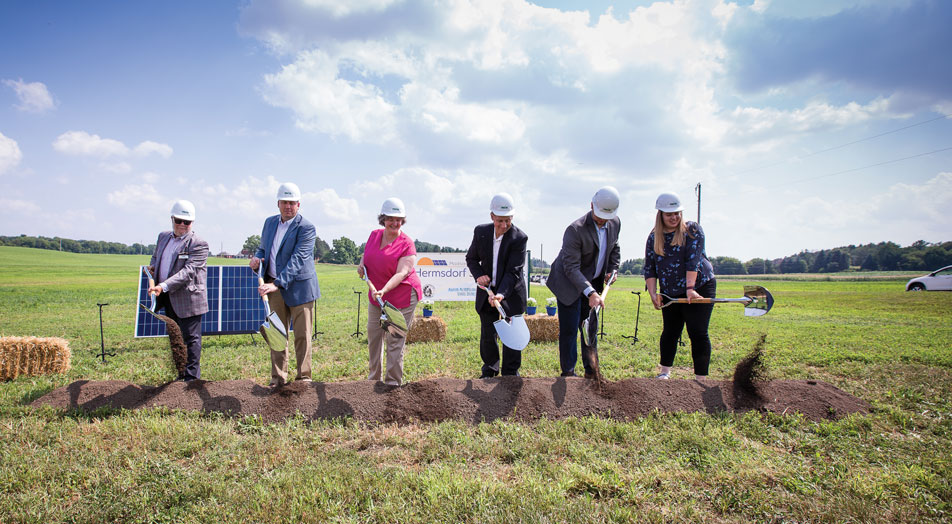 Vice President of Energy Technology Don Peterson; Chairman, President and CEO Jeff Keebler; Madison Mayor Satya Rhodes-Conway and members of the Hermsdorf family break ground in July 2021 for the Hermsdorf Solar Fields, which will help power City of Madison and Madison Metropolitan School District operations.
Vice President of Energy Technology Don Peterson; Chairman, President and CEO Jeff Keebler; Madison Mayor Satya Rhodes-Conway and members of the Hermsdorf family break ground in July 2021 for the Hermsdorf Solar Fields, which will help power City of Madison and Madison Metropolitan School District operations.
Green pricing program
Green Power Tomorrow (GPT) is our green pricing program. At a penny more per kWh, GPT is a convenient and effective way for customers to support local and regional renewable energy and offset their greenhouse gas emissions.
Today, more than 10,300 customers buy green power through this program. Our GPT program is largely served by our wind resources in the region.
Customer-owned solar
We also work with customers who want to install solar to help power their homes or businesses. These customers connect to our community grid and sell their excess electricity to MGE. We have partnered with nearly 1,600 customers to connect their solar installations to our grid.
Collaborations with our communities
MGE has ongoing collaborations with a number of communities, including the cities of Fitchburg, Madison and Middleton. These partnerships serve to advance shared goals around renewable energy, electric vehicles (EV), and energy efficiency and conservation.
MGE also serves as a member of the Dane County Council on Climate Change. The council includes local government, businesses, utilities and environmental organizations. MGE’s partnership with local stakeholders through the council offers another opportunity to work toward common goals, including deep decarbonization.
Accelerating sustainability
MGE is a longtime partner of Sustain Dane, a local organization that has offered innovative programs for local businesses for more than 20 years. During this time, Sustain Dane has been recognized as a leader in helping local organizations set and achieve sustainability goals. MGE and the City of Madison have partnered with Sustain Dane to host Accelerate Sustainability Workshops, which help local professionals learn more about sustainability best practices through local case studies.
Advancing energy efficiency, conservation and new technologies
Energy efficiency is a key strategy for reducing carbon emissions. MGE is committed to providing customers with the tools and resources they need to make wise energy choices that help reduce their individual carbon footprints.
We strive to “meet customers where they are” to engage them in energy efficiency. Through the use of new technologies, hands-on workshops, energy education, conservation kits and innovative rate options, MGE is helping to empower customers to take control of their energy use to better manage long-term costs and to achieve deep decarbonization.
Managing demand with smart thermostats
Electric use peaks during stretches of hot, humid days when air conditioners run in a majority of homes and businesses. These periods of high electric use put pressure on utilities to generate and distribute enough electricity to everyone who needs it.
Nearly 2,500 households participate in MGE Connect®, our smart thermostat demand response program for residential customers. With customers’ permission, minor temperature adjustments are made to their smart thermostats to reduce energy use during periods of high demand.
The program helps MGE better understand the role and impact of smart devices in helping manage our community grid while helping customers reduce their energy use with minimal possible impact on comfort.
MGE also works with partners, such as FOCUS ON ENERGY®, Project Home and community organizations, to make smart thermostats and other energy-saving improvements available to lower-income households. MGE is committed to working with customers and our partners to help ensure all customers have the opportunity to share in the benefits of new technologies.
Working with Focus on Energy
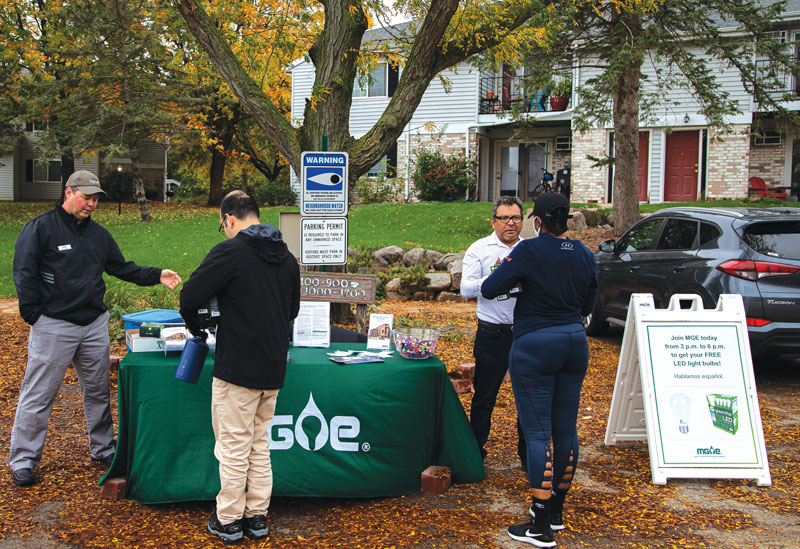 MGE's Residential and Community Services team worked with Focus on Energy to distribute LED light bulbs to lower-income customers at outdoor events in 2021.
MGE's Residential and Community Services team worked with Focus on Energy to distribute LED light bulbs to lower-income customers at outdoor events in 2021.
Focus on Energy, Wisconsin’s statewide energy efficiency and renewable resource program, is MGE’s partner in educating customers about the value of energy efficiency and conservation. MGE works with residential and commercial customers seeking incentives and rebates through Focus on Energy to make energy-saving improvements.
In 2020, MGE customers received more than $1.5 million in financial incentives from Focus on Energy for heating and cooling improvements, smart thermostats, insulation and air sealing, and renewable energy technology.
Our Residential and Community Services team and many of MGE’s community partners also worked with Focus on Energy to get energy efficient light bulbs into lower-income customers’ homes. The team distributed thousands of LED light bulbs at outdoor community events in 2021.
Conserving energy with On Demand Savings
MGE’s On Demand Savings (ODS) program offers large customers tools and strategies to reduce their energy use, especially during periods when demand for electricity is at its peak. ODS uses an online dashboard to give customers near real-time energy usage information, enabling them to act to cut costs and to reduce their environmental footprint. Some additional features for program participants include:
- Alert notifications by email or text to participants when their building load exceeds a specified threshold.
- Monthly energy challenges that allow participants to set monthly demand and energy goals that are tracked in the system.
- Energy markers that provide participants with the ability to track energy performance from a specific project or milestone before and after a specified date.
The program was recognized in 2018 with an Inspiring Efficiency Award for Innovation by the Midwest Energy Efficiency Alliance, a regional organization dedicated to advancing energy-efficient technologies, products and best practices.
A third-party evaluation of the program completed in 2021 revealed high levels of customer satisfaction. The evaluators found an average demand reduction of 3.3% across all participating sites and a 4% reduction in energy use.
Residential battery pilot
In late 2020, we launched a new technology demonstration project featuring battery storage in collaboration with the Electric Power Research Institute and residential electric customers. Several homeowners who have a solar photovoltaic system have a battery installed outside their home. The rooftop solar system charges the batteries, which will be used during times of peak demand and as a backup source of power for the household. This project will help us understand how batteries operate in Wisconsin temperatures and how batteries could help control long-term costs by managing our collective use of energy. Battery storage also could provide enhanced reliability as we continue our transition to greater use of renewable resources.
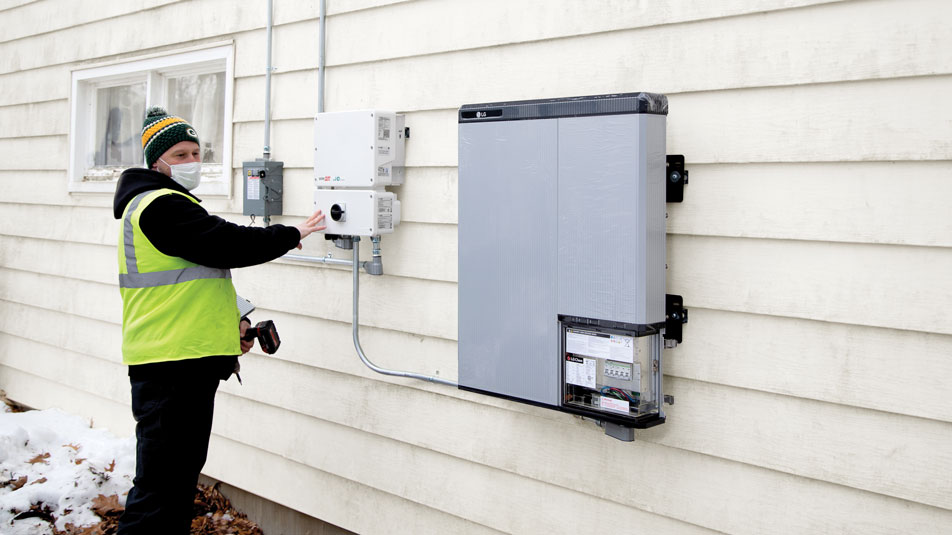 MGE is partnering with a number of homeowners who have rooftop solar arrays to test residential battery storage to better understand how the technology could be used to manage peak demand and to enhance reliability.
MGE is partnering with a number of homeowners who have rooftop solar arrays to test residential battery storage to better understand how the technology could be used to manage peak demand and to enhance reliability.
Meeting customers where they are
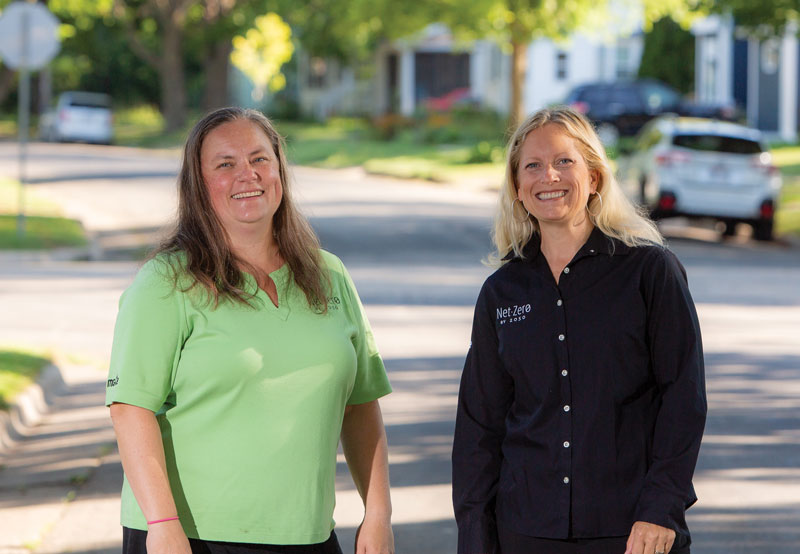 Residential services managers Leah Samson and Laura Paprocki serve as MGE energy experts, engaging customers in a variety of ways to help them use energy wisely and achieve shared energy goals.
Residential services managers Leah Samson and Laura Paprocki serve as MGE energy experts, engaging customers in a variety of ways to help them use energy wisely and achieve shared energy goals.
Our Residential and Community Services team continues to connect in new ways with customers around energy efficiency, new technologies and other energy-related needs. Deepening our engagement with customers is one of our objectives under our Energy 2030 framework.
With a partnership to offer free conservation kits and LED light bulbs from Focus on Energy and outreach to introduce customers to our online tools, our energy experts work with community partners and customers throughout the area to answer questions about customer bills, help customers understand their energy usage, identify resources for assistance and more.
Throughout the COVID-19 pandemic, MGE residential and commercial account representatives reached out to customers and community partners to help point customers to resources for assistance and to let them know of our commitment to providing safe, reliable service throughout the pandemic.
Energy expert line and customer engagement
MGE’s Home Energy Line to “ask the experts” is an efficient way for customers to get energy tips and answers to their energy-related questions via phone or email. In 2020, MGE energy experts provided individualized advice to more than 1,500 customers and conducted targeted digital engagement with more than 9,000 customers and community partners throughout the year. Our energy experts worked with customers to help them better understand flexible payment plans and energy efficiency resources. This included outreach to customers who were behind on their bills due to the pandemic.
MGE also maintains a separate line for commercial and industrial customers who need assistance.
Portable energy meters
MGE has donated more than 50 portable energy meters to area libraries for customers to use. The meters measure voltage, electricity cost and electric consumption. They help customers identify the potential causes of high energy use and better understand the exact operating costs of various items in their homes.
Energy education for our youth
We partner with local teachers, schools and summer programs from elementary school through college to help educate thousands of students about energy, safety, electric transportation, new technologies and career opportunities in the industry. In 2021, MGE produced a series of videos in both English and Spanish to help educate lower elementary students about solar energy and EVs.
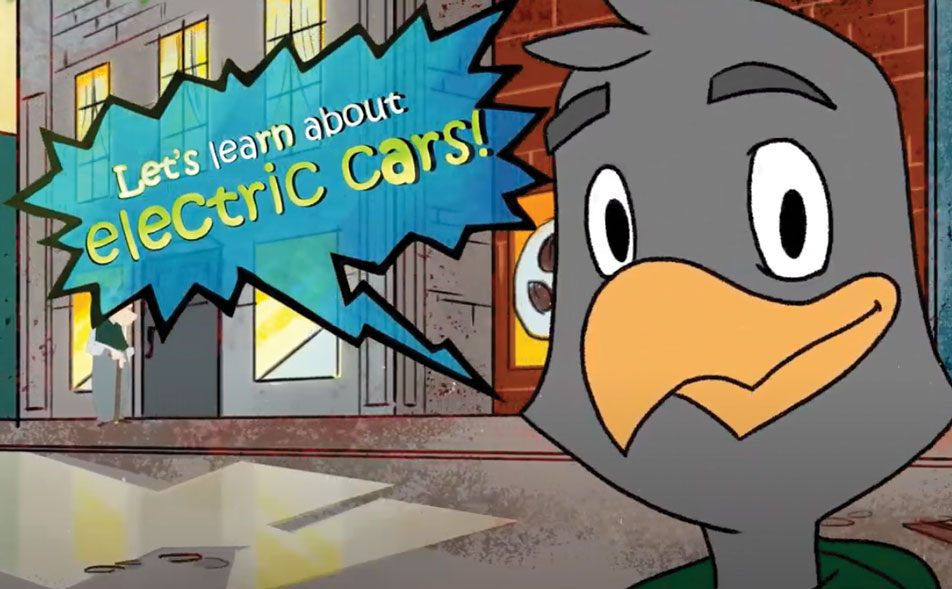
Online resources
Simple, cost-effective energy-saving tips for homeowners, renters and businesses are available online from MGE. Customers also can compare their energy use and learn what has helped other customers save. For example, using My Account at mge.com, customers can review their bill, payment history and past energy use and sign up for MGE services. We share energy-saving tips, tools and information on our social media channels and online at:
- mge.com
MGE’s primary site for customer services; account access, paperless billing and bill payment; safety and outage information; and other news, information, programs and services from MGE. - mge2050.com
A source for clean energy news, energy-saving tips and information. The site includes locally based videos and features articles around saving energy, MGE’s new programs and services, and initiatives for working together to achieve net-zero carbon electricity by 2050. - genre2030.com
Features films and energy-related content with the goal of engaging MGE’s millennial customers in the company’s Energy 2030 framework for a more sustainable future. - livinginbalancemadison.com
Shares stories from MGE’s diverse customer base about what it means to be sustainable from community members who are living it every day.
Leading the charge for transportation electrification
Transportation is the leading contributor of greenhouse gas emissions in the U.S. The electrification of transportation is a key strategy for reducing carbon emissions. In addition to growing our use of renewable resources and engaging around energy efficiency, we are working with customers, stakeholders, municipalities and other community partners to grow the use of EVs and to facilitate charging options throughout our community.
We have been advancing alternative fuel vehicles since we began building our EV public charging network more than 10 years ago. Today, the number of EVs on the road continues to grow. MGE is prepared to meet the need with our growing public charging network of 45 stations—powered by wind energy—and programs to facilitate charging at home, at work and on the go. Our public charging network features several DC fast chargers, which can provide 60 to 80 miles of range in about 20 minutes.
Fast charger hub
MGE began construction in summer 2021 of a new EV fast charging hub in the heart of Madison’s Capitol East District. One of the first of its kind in Wisconsin, the charging hub located along a major thoroughfare in downtown Madison is expected to begin serving EV drivers in late 2021. The new fast charging hub will provide convenient EV charging—powered by renewable energy—for nearby apartment and condo dwellers and single-family households, commuters, taxi and ridesharing services as well as EV fleet vehicles.
With power levels up to 350 kilowatts, the hub’s high-speed chargers will be some of the most powerful EV chargers in the Midwest. These chargers will support fast charging for EVs with greater driving ranges in the future. Through a partnership with Tesla, the hub also will have eight Superchargers from the electric car maker.
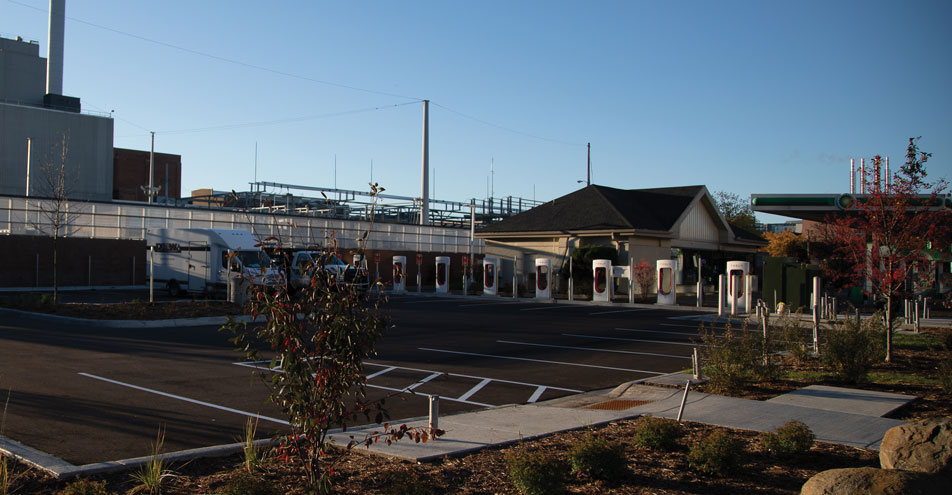
Enabling charging options
Charge@Home, MGE’s home charging program, makes it easy for EV drivers to charge efficiently at their home, which is where more than 80% of charging happens. With Charge@Home, MGE owns, maintains and coordinates the installation of Level 2 charging stations at customers’ homes. With no upfront cost, customers pay a monthly fee plus the cost of electricity. The program gives MGE the ability to study drivers' charging habits and to explore remote management of charging sessions to better understand the potential impact of EVs on the grid, including how grid management can help to lower costs for all MGE customers by optimizing our use of resources.
MGE also helps area employers of all sizes and multifamily developers who want to offer employees and residents charging. We discuss options and help them navigate the decision-making and implementation process.
Connecting potential EV drivers with local dealerships
In 2021, MGE launched its Dealership Network to serve customers who are considering an EV. Local dealerships that are members of MGE’s Dealership Network are knowledgeable about EV programs and resources offered by MGE. In addition to expertise on models, trim options, driving ranges and financing, dealerships can help drivers determine the best charging solution for their new EV. Through MGE’s family of EV websites, customers are able to connect with local dealers to get their questions answered or to schedule a test drive.
MGE's EV fleet goal
We have been testing commercially available EVs for more than a decade. We are continuing to add cleaner vehicles to our fleet, where possible, and are targeting a goal of 100% all-electric or plug-in hybrid light-duty vehicles by 2030.

Our fleet includes a plug-in electric pickup truck and Ford Escapes, a step van and bucket trucks with battery-powered technology, and all-electric passenger vehicles.

EV engagement at MGE
MGE seeks to engage our employees in our efforts to grow the use of EVs. We offer five workplace charging stations, each with dual ports, to enable charging for employees while at work. Workplace charging offers many benefits, including employee attraction and retention and support for sustainable initiatives.
Electric buses in Madison
The City of Madison is adding three all-electric buses to its public transportation fleet. MGE worked with the City's Metro Transit to secure a $1.3 million federal grant for the zero-emission buses and contributed 100% of the required local matching funds for charging infrastructure for the buses. As part of the ongoing collaboration to electrify the City's bus fleet, MGE is providing continued in-kind support and expertise to address technological issues and to facilitate the cost-effective and efficient use of energy.
Zero-emission buses will play a key role in efforts to reduce carbon emissions. According to the U.S. Department of Transportation, for every zero-emission bus on the road, carbon emissions are reduced by nearly 1,700 tons over their estimated 12-year life span. With three electric buses, that would be an estimated carbon reduction of 5,100 tons.
MGE continues to work with the City to seek ways to further the electrification of transportation. When the City received a Wisconsin Office of Energy Innovation grant to help purchase 20 all-electric Chevy Bolts, MGE partnered with the City to provide charging infrastructure for the new fleet vehicles.
Electric fire truck
MGE also has partnered with the City of Madison Fire Department to enable fast charging for the department’s first electric fire truck. The fire truck, manufactured by Pierce Manufacturing based in Appleton, Wis., began serving the community in mid-2021.
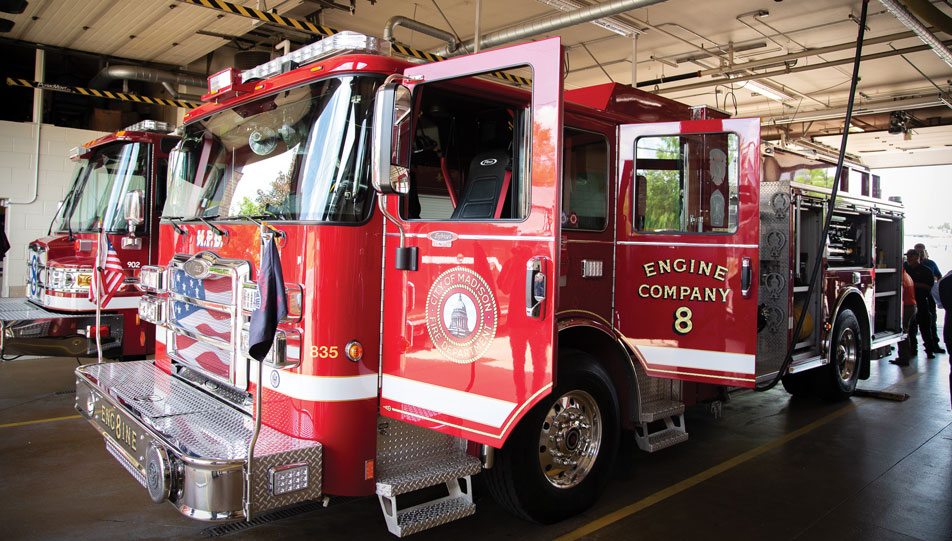
Managed charging technology demonstration
MGE is partnering with Tesla drivers in our service territory to test how smart charging using vehicle telematics can save customers money and help plan for the impact of EVs on our grid. Customers on a time-of-use rate who sign up to participate in the project have their EVs automatically charge off-peak. By shifting charging to off-peak times, customers can save on their electricity costs. Customers on a standard rate have their EV charging optimized to keep the grid balanced and receive a nominal incentive each month. Additionally, a group of customers has the opportunity to participate in demand response events to receive additional rewards. The opportunity to shift EV charging to lower-cost times and when more resources are available will help us prepare for more EV charging on our distribution grid. Managed charging may benefit all MGE customers by reducing the need for electrical system upgrades and new generation facilities long-term.
Partnering with local school districts
MGE partnered with the Madison Metropolitan School District to install a charging station to serve its electric fleet vehicles. In addition to ongoing educational partnerships, MGE continues to work with local schools to evaluate charging options for their facilities.
Working with regional stakeholders
As part of the Great Plains Institute’s Midcontinent Transportation Electrification Collaborative (M-TEC), we’re working with other utilities, state governments, automakers, EV charging companies and environmental groups to advance EV infrastructure and increase the use of EVs. Working together, our group conducts research, develops white papers and policy recommendations, and hosts workshops for stakeholders in the region. In 2021, M-TEC urged Congress to support investments in EV charging infrastructure; to keep the automotive supply chain in the U.S. by supporting EV and EV component manufacturing; and to support EV research, development and demonstration.
Sustainable Transportation Series
MGE again partnered with Wisconsin Clean Cities, the City of Madison and others to present a virtual educational series for fleet and transportation professionals in fall 2021. MGE’s manager of electrification moderated a panel on how Wisconsin companies are working to electrify their fleets.
Resources and tools to educate drivers
MGE helps to educate customers, businesses and our community at-large about the benefits of EVs. Our experts have been on hand at many community events with a variety of EVs to share information on driving and charging EVs.
For example, each year, MGE sponsors the National Drive Electric Week event held in Madison. In 2021, local EV drivers registered to showcase their vehicles to attendees. MGE EV experts were available to share information about EVs and EV charging.

In 2018, MGE launched our LovEV website to help customers discover why “there’s a lot to love” about EVs. LovEV highlights available models, explains charging options, and details cost and environmental savings. It is an easy, one-stop online resource at mge.com/LovEV.
The online tool, Explore My EV, gives users the opportunity to compare the costs of plug-in hybrid and all-electric vehicles to gasoline-powered models. The tool, available at
EV Owners Group
EV drivers who participate in MGE’s EV Owners Group receive a 50% discount on public charging. In exchange, EV drivers allow their charging information to be shared with MGE to help us better understand public charging behavior and its impact on the grid. MGE also partners with group members to gather feedback on EV programs, pilots and services.
Collaborating to advance sustainability and innovation
By working together with our customers and other stakeholders, we can develop solutions to the energy challenges of our times and reach our shared energy goals. For example, MGE is a partner in the Midcontinent Power Sector Collaborative (MPSC) facilitated by the Great Plains Institute out of Minneapolis, Minn.
The MPSC, consisting of utilities, agencies, non-governmental organizations and environmental groups, worked together to develop the Road Map to Decarbonization in the Midcontinent: Electricity Sector. MGE’s local partners in the MPSC include the nonprofit Clean Wisconsin and the Dane County Office of Energy and Climate Change.
The MPSC brings together diverse viewpoints and priorities to develop options to continue driving toward a lower carbon future and to better inform policymakers. The MPSC is one of many partnerships in which MGE is involved to further sustainable energy.
MGE also works with key partners to examine and design innovative programs and grow ideas in a focused, deliberate fashion. Working together is part of how MGE identifies ways that we can be responsive to our customers’ evolving energy needs while ensuring a modern, sustainable electric system. Some of MGE’s pilot programs, such as Shared Solar, On Demand Savings, renewable flat bill, smart thermostat demand response (MGE Connect) and Charge@Home, have been informed by these collaborative efforts.
Partnering to grow innovation
MGE’s parent company, MGE Energy, is an investor and supporter of Energy Impact Partners (EIP), a utility-focused investment fund. Participation in EIP and similar funds offers MGE Energy the opportunity to invest in early-stage companies that are working to advance sustainability, smart technologies, distributed energy resources and electrification. Involvement in EIP also gives MGE the ability to explore new or emerging technologies through working groups and pilot programs that allow us to partner with our customers.
Ensuring reliability
MGE is a national leader in electric reliability. We are committed to transitioning to greater use of renewable resources while maintaining our top-ranked reliability. According to an annual industry survey including more than 75 electric utilities nationwide, in 2020, MGE experienced its best performance ever in the two main industry reliability metrics—fewest number of outages (SAIFI) and the shortest duration of outages per customer (SAIDI).
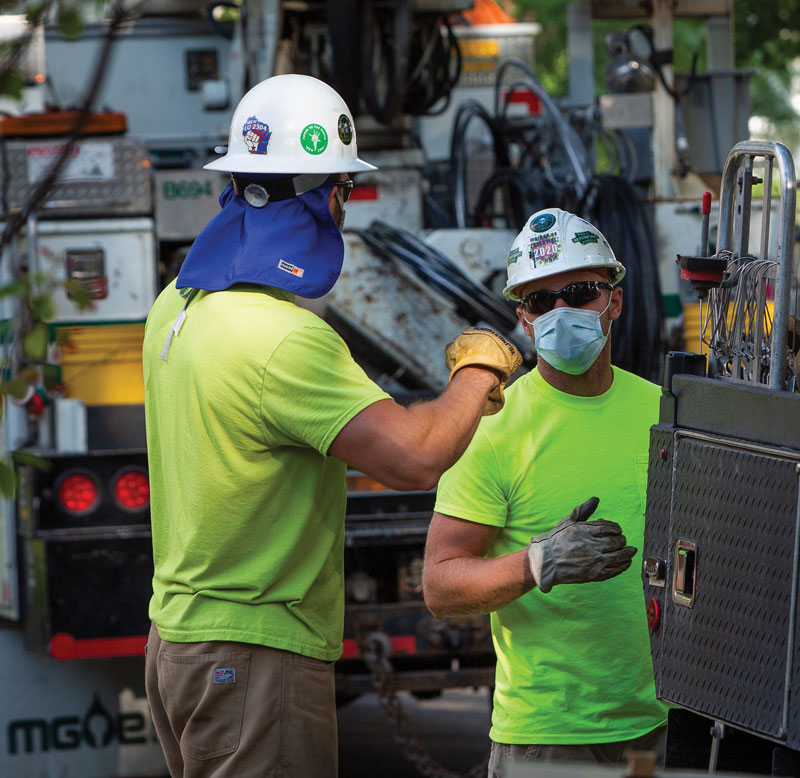
SAIFI, which measures the frequency of customer outages, was 0.24 in 2020, the best in MGE’s history. The company’s previous best was 0.33 in 2015. This measure means, on average, MGE customers experience about one outage every four years. SAIDI, which measures total customer outage times, was 27.3 minutes in 2020. MGE’s previous best was 27.9 minutes in 2013. MGE's 2020 result is 95% lower than five-year nationwide average of electric utilities, which is an outage time of 509 minutes.
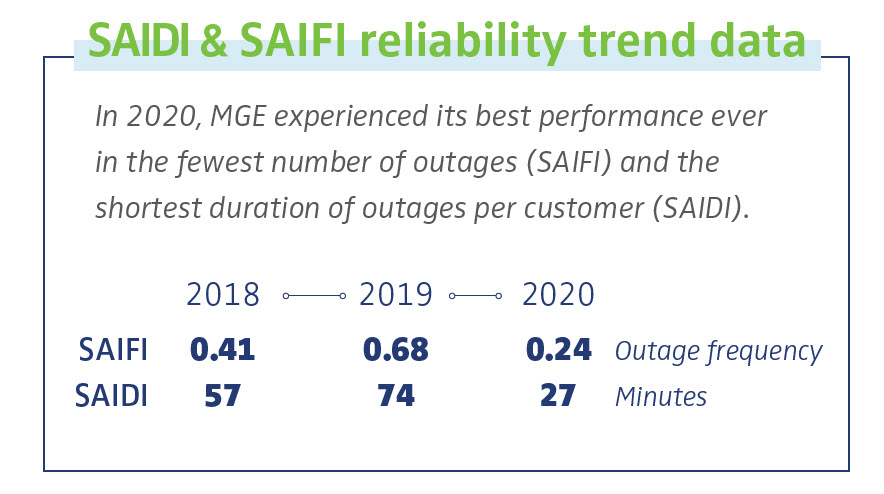
Utility as conductor of the grid of the future
We take seriously our responsibility and commitment to those we serve. The electric grid is a shared resource for the benefit of everyone, providing for the safety and security of a community through safe, reliable electricity.
We’re investing in the systems and capabilities to enable an electric grid that supports new technology such as distributed energy sources like solar and battery storage. We have an important role to play to ensure that new resources and technologies are harnessed for the benefit of all customers.
This increasingly more advanced electric grid requires a conductor to ensure the system develops and operates in a way that keeps electricity safe, reliable and affordable for everyone. As the public utility, MGE serves as this conductor for our community grid.
When the utility serves as the conductor of the electric grid, new technologies and resources can add value to the system because the utility is able to dispatch generation and balance demand as needed. With more sources of two-way power flows—power flowing to the customer from the grid and power flowing from the customer’s generation back onto the grid—a single conductor system provides efficiency in coordinating the different sources of power and the various needs of the grid in real time to maintain a safe and reliable power supply.
This orchestration benefits the utility as well as customers because it helps to ensure the system operates efficiently and is sized appropriately. The utility as conductor can optimize the efficiency and use of the electric system’s assets to help control costs and optimize benefits and value over time, which leads to lower costs for all customers. The benefits of grid resiliency, reliability and a more efficiently managed power system are captured for all customers, individually and collectively.
Today’s customer expects a grid that integrates all sorts of energy technologies in a way that gives them choice, flexibility and value. New technology is changing how we plan for the energy grid of the future; however, our obligation to serve customers and communities 24 hours a day, seven days a week, 365 days a year remains unchanged.
